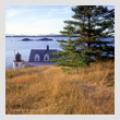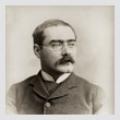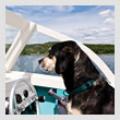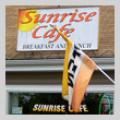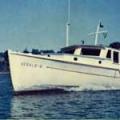Island Hopping in the TUB
All photos courtesy Robin Hood Camp
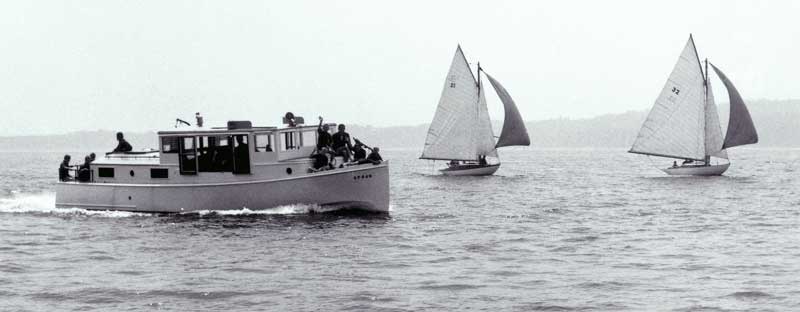 Eggemoggin Reach was the home base for the Niacel III and Robin Hood Camp’s two gaff-rigged Manchester 17 sailboats. Like the Niacel, the sailboats are no longer with us.
Eggemoggin Reach was the home base for the Niacel III and Robin Hood Camp’s two gaff-rigged Manchester 17 sailboats. Like the Niacel, the sailboats are no longer with us.
The Niacel III was a 38-foot cabin cruiser built in 1928 by the Matthews Boat Co. in Port Clinton, Ohio. But I called it the Nia-Tub—with affection, of course.
The Niacel III wasn’t just any boat. It was the vessel on which I first learned about and explored Maine’s islands, bays, coves, harbors, and shoreline as a youngster. It was where I developed my love and appreciation for the Maine coast.
My grandfather, Frederic B. Littlefield, founded and owned Robin Hood Camp, a summer camp in Brooksville whose campus was on both a lake and Eggemoggin Reach. Robin Hood used the Niacel III to take campers on three- or four-day cruises as part of the summer camp experience.
When a camp director stood in front of the 100 or so campers sitting on the lakeside campfire benches to announce an upcoming cruise, campers waited with anticipation and excitement to see if their names would be among those who were called.
Campers were assigned a position: Captain, First Mate, Second Mate, Third Mate, Bosun, Steward, and so on. There was no greater tribute than being named the captain of a cruise, but I was never bestowed that honor.
The Niacel III was christened the Meda when it was launched, and was later renamed for Capt. Jim LeCain—Niacel spelled backwards. He was before my cruising time of the late 1960s and early ’70s, but I am told that it was named the Niacel III because Capt. LeCain had a son, Jim LeCain Jr., so they named the boat the third.
 The Niacel III was a common—and memorable—sight when loaded with campers and counselors while cruising the Maine coast from Penobscot Bay to New Brunswick from the 1950s to the 1980s.
The Niacel III was a common—and memorable—sight when loaded with campers and counselors while cruising the Maine coast from Penobscot Bay to New Brunswick from the 1950s to the 1980s.
The cruises left from a dock on Eggemoggin Reach, where the boat was moored along with two Robin Hood sailboats that were used to teach campers about ocean sailing. When it was time to leave, campers would trudge from the camp on Walker Pond to the dock at a God-early hour, carrying duffel bags loaded with clothing, sleeping bags, and whatnot. We wore our camp uniforms—we called them “greenies”—of green shirts and green shorts with red stripes down the sides.
The three or four counselors would bring food and other provisions, while the real captain would make sure the gasoline-powered engine was in order and ready to go. During my years of cruising, I remember a Capt. Lawrey, and a Capt. Condon who stood barely 5 feet tall on his tiptoes.
And off we’d go, heading either east toward Mount Desert Island or west toward the Camden Hills aboard the Nia-Tub, a box-shaped boat that I thought resembled a big floating bathtub.
With the boat cruising at 12 to 15 knots, campers sprawled out in the center cabin, which had cushioned seating on the sides and where the captain manned the wheel and monitored the marine radio with the call sign of Whiskey Kilo 3805. The boat had a storage area forward with two berths, a lower cabin aft where we stored the duffel bags, and a rear deck. Wearing our old-fashioned orange life jackets, we also sat on top of the roof above the aft cabin and on the bow, which required some tricky maneuvering to get to.
The cruises I was on took us through Penobscot, Jericho, Blue Hill, and Frenchman bays. One time a storm rolled in and we bobbed like a cork in 12-foot swells, some of the campers turning green and throwing up off the rear deck.
When we stopped cruising for the day, the captain would anchor off an island and counselors would ferry the campers and our gear in on a wooden tender that we towed behind the Niacel III. The tender had a 7.5-hp Evinrude on its stern, bought from Condon’s Garage in Bucks Harbor, which is featured in Robert McCloskey’s children’s book One Morning in Maine.
Among the islands we visited were Butter, Bradbury, Pond, Russ, Camp, and Hog. One time we stopped at Sears Island in Searsport, which I thought (as a 10-year-old) was in the middle of nowhere, only to later find out that it was connected to the mainland. On the shore of Sears Island, a counselor told us to put our sleeping bags on top of the dried seaweed, since it would be soft like a mattress. He neglected to warn us about the sand fleas that jumped into our sleeping bags that night.
 This boathouse sheltered the Niacel III during the off season before falling down one winter under the weight of heavy snow. In the end, the boat was cut up with a chainsaw into manageable pieces and carted away for disposal.
This boathouse sheltered the Niacel III during the off season before falling down one winter under the weight of heavy snow. In the end, the boat was cut up with a chainsaw into manageable pieces and carted away for disposal.
Once on an island, we would build a campfire that we used for cooking and to tell ghost stories around after the sun went down. Cruises were special because we had a choice of lobster or steak, a nice change from the usual camp gruel. As a counselor, I once led a cruise in the early ’80s where half the campers wanted peanut butter and jelly sandwiches, not surf or turf. Rather than let the lobsters go to waste, I ate eight of them in one sitting.
I remember my grandfather once standing before the camp saying the Niacel III had once taken campers to Jonesport and even to Canada, and would do so again weather permitting. For years, I chuckled at that memory, thinking he was telling a tall tale. But I recently learned that the Niacel III did indeed once venture to Jonesport and then to Grand Manan Island, which is part of New Brunswick. I am told it also once visited Canada’s Campobello Island, near Lubec.
A former counselor this winter sent me photos of the Niacel III at Grand Manan in the early ’60s. But the real excitement of that cruise, he said, happened in Jonesport. “I remember a Coast Guard boat was lurking around Jonesport and might inspect us for carrying too many passengers (more than 20, I recall!),” he wrote. “So we quickly veered left out of the channel to a pier. We told half the campers and counselors to run up and find a soda shop in town to hide in until the danger was past.”
As the Niacel III got older, it had its aches and pains and breakdowns. The original V-8 engine was replaced with a Ford Osco engine. During the offseason, it was kept in a boathouse on shore, and later (after the boathouse fell down), I recall it being stored outside under a blue tarp.
Long after my camper and counselor days at Robin Hood, the Niacel III disappeared for good. I am told it took two guys the better part of a week to chainsaw it into manageable pieces; by that time, it was just the hull, a caved-in cabin and the cradle in which it rested. They then used a Ford F250 pickup that counselors called the Green Monstah to drag the pieces up a dirt road to a small field along a paved road. There, a pulp truck came and took it away to God knows where. And with that, I offer a belated RIP to the Niacel III.
✮
Clarke Canfield is a longtime journalist and author who has written and edited for newspapers, magazines, and the Associated Press. He lives in South Portland with his wife.
Related Articles
Share this article:
2023 Maine Boat & Home Show

Join Us for the Maine Boat & Home Show!
Art, Artisans, Food, Fun & Boats, Boats, Boats
August 11 - 13, 2023 | On the waterfront, Rockland, Maine
Click here to pre-order your tickets.
Show is produced by Maine Boats, Homes & Harbors magazine.








